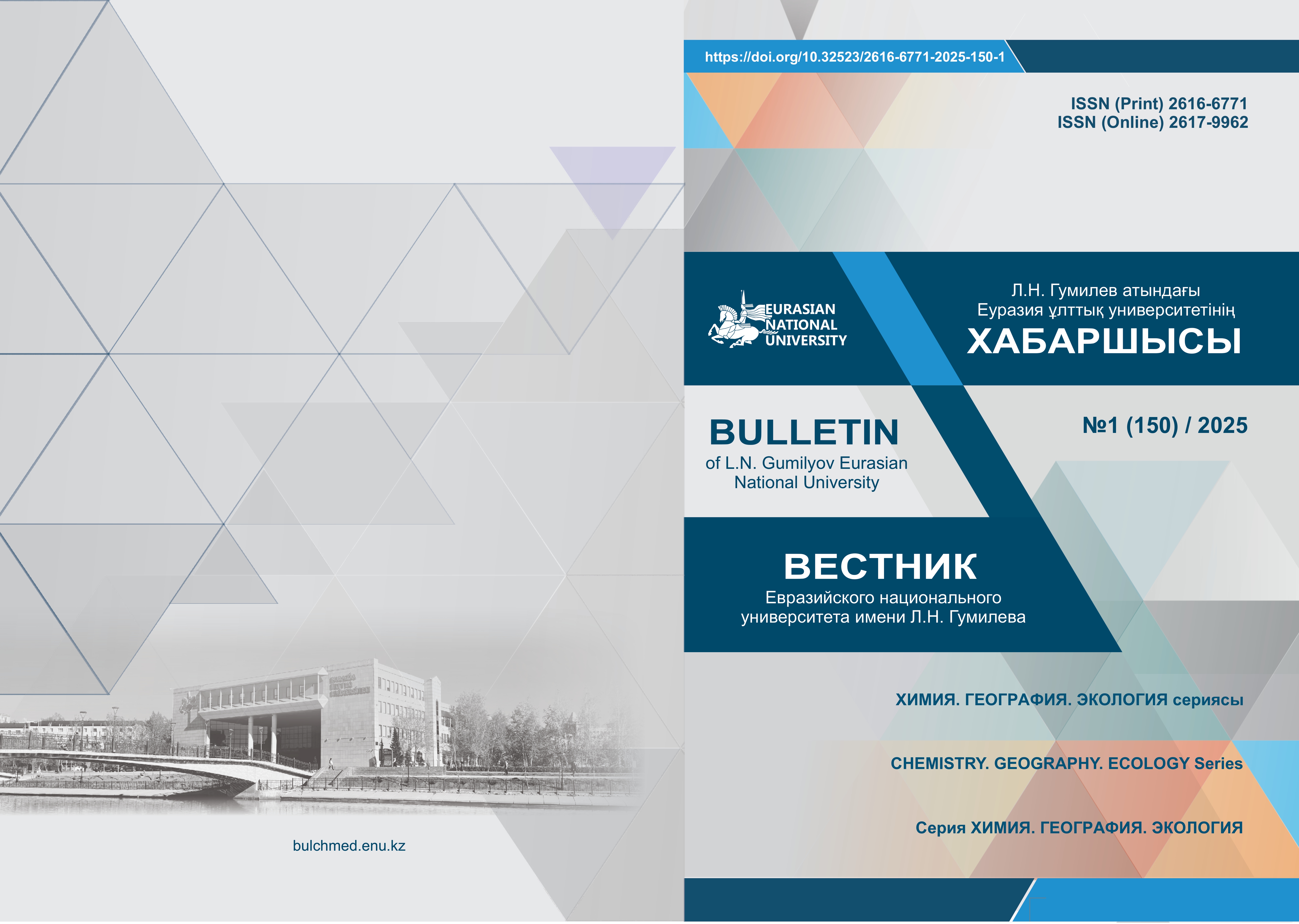The current state of the thermal power system of the Republic of Mordovia in the context of sustainable development
Views: 436 / PDF downloads: 108
DOI:
https://doi.org/10.32523/2616-6771-2025-150-1-185-202Keywords:
thermal power engineering, thermal power system, history, formation, condition, sustainable development, climate, climate warming, Republic of MordoviaAbstract
The consideration of the history of formation and development, as well as the current state of the thermal power system in any region, plays an important role in determining the directions and prospects for its further development. This is particularly relevant in the context of global climate change, and also allows us to identify the features of the geographical distribution of elements of the heat and power system and the existing territorial imbalances in the distribution of elements. This was the purpose of this study in relation to the territory of the Republic of Mordovia.
At the beginning of 2024, 13 thermal power plants and 1 small hydroelectric power plant with a total capacity of 434 MW were operating in the region. A special feature of the development of the energy system is the absolute dominance of one station, Saranskaya CHPP-2. In addition, it has been determined that the city of Saransk accounts for more than 70% of all electricity generation and consumption. This phenomenon can be attributed to the presence of significant consumers within the city's boundaries, as well as the high population density within the city, which is estimated to account for up to half of the Republic's population.
A fairly clear and steady trend towards an increase in electricity consumption has been established. The energy system of Mordovia is characterized by the transition to the use of natural gas as the main fuel and the achievement of one of the highest levels of gasification and electrification in the country (95%). The specific values of thermal energy consumption per 1 m2 of living space and electricity per 1 person decreased in most areas, which is associated with a decrease in population and partly, presumably, with global warming processes due to climate change and energy sustainability.
Downloads
References
Ataev, Z. A. (2008). Geograficheskie osnovy lokal'noi energetiki Tsentral'nogo ekonomicheskogo raiona Rossii: monografiia [Geographical Foundations of Local Energy in the Central Economic Region of Russia: Monograph]. Ryazan.
Bellamy, R., Chilvers, J., Pallett, H., & Hargreaves, T. (2022). Appraising sociotechnical visions of sustainable energy futures: A distributed deliberative mapping approach. Energy Research and Social Science, 85, 102414. https://doi.org/10.1016/j.erss.2021.102414
Bespalova, N. V., & Teslenok, S. A. (2019). Analiz osobennostei izmeneniia srednei mnogoletnei temperatury vozdukha po sezonam goda na territorii Respubliki Mordoviia [Analysis of Long-term Average Air Temperature Changes by Seasons in the Republic of Mordovia]. In XLVII Ogarevskie chteniia. Materialy nauchnoi konferentsii [XLVII Ogarev Readings. Conference Proceedings] (Vol. 2, pp. 374–379). Saransk.
Bossink, B., Blankesteijn, M. L., & Hasanefendic, S. (2023). Upscaling sustainable energy technology: From demonstration to transformation. Energy Research and Social Science, 103, 103208. https://doi.org/10.1016/j.erss.2023.103208
Bugaje, A. B., Dioha, M. O., Abraham-Dukuma, M. C., & Wakil, M. A. (2022). Rethinking the position of natural gas in a low-carbon energy transition. Energy Research and Social Science, 90, 102604. https://doi.org/10.1016/j.erss.2022.
D’Orazio, P. (2023). Charting the complexities of a post-COVID energy transition: Emerging research frontiers for a sustainable future. Energy Research and Social Science. https://doi.org/10.1016/j.erss.2023.103365
Edinaia energeticheskaia sistema Rossii [Unified Energy System of Russia]. (2021). System Operator of the Unified Energy System: Official Website. https://www.so-ups.ru/functioning/ups/ups2021/
Elektrostantsii Respubliki Mordoviya [Power Plants of the Republic of Mordovia]. (2024). EnergyBase. https://energybase.ru/region/respublika-mordoviya/power-plants
Gielen, D., & Bazilian, M. D. (2021). Critically exploring the future of gaseous energy carriers. Energy Research and Social Science, 79, 102185. https://doi.org/10.1016/j.erss.2021.102185
Green, E. (2023, December 12). Ustoichivaia energetika i izmenenie klimata [Sustainable Energy and Climate Change]. Sigma Earth. https://sigmaearth.com/ru/устойчивая-энергетика-и-изменение-климата/
Green, E. (2023). Tekhnologii ustoichivoi energetiki v 2024 godu [Sustainable Energy Technologies in 2024]. Sigma Earth. https://sigmaearth.com/ru/технологии-устойчивой-энергетики-в-2024-году/
Gromov, D. V., Kochurov, B. I., Peretochenkov, E. A., Peretochenkova, O. U., & Pyatanov, A. V. (2023). Teploenergeticheskii rynok Privolzhskogo federal'nogo okruga [Heat Energy Market of the Volga Federal District]. Ogarev-online, https://journal.mrsu.ru/arts/teploenergeticheskij-rynok-privolzhskogo-federalnogo-okruga
Gromov, D. V., Peretochenkova, O. U., & Pyatanov, A. V. (2022). Innovatsii v energetike v regionakh Privolzhskogo federal'nogo okruga [Innovations in Energy in the Regions of the Volga Federal District]. Ogarev-online, 2. https://journal.mrsu.ru/wp-content/uploads/2022/03/statya_pyatanov-gromov-peretochenkova-3.pdf
Ivlieva, N. G., Manukhov, V. F., & Khlevina, S. E. (2013). Prostranstvenno-vremennoi analiz izmeneniia klimata v zone shirokolistvennykh lesov pravoberezh'ia Volgi [Spatio-temporal Analysis of Climate Change in the Broadleaf Forest Zone of the Right Bank of the Volga]. InterCarto/InterGIS, 19, 62–68. https://doi.org/10.24057/2414-9179-2013-1-19-62-68
Jesse, B. J., Kramer, G. J., & Koning, V. (2024). Characterization of necessary elements for a definition of resilience for the energy system. Energy, Sustainability and Society, 14, 46. https://doi.org/10.1186/s13705-024-00478-9
Lindbergh, S., He, Y., & Radke, J. (2022). Beyond carbon: Unveiling vulnerabilities of the transportation fuel system for climate resilience. Energy Research and Social Science, 114, 103585. https://doi.org/10.1016/j.erss.2024.103585
Loginova, N. N., Maslyaev, M. V., & Maslyaev, V. N. (2018). Sistema energosnabzheniia sel'skoi mestnosti Mordovii: ekonomiko-geograficheskie aspekty [Energy Supply System of Rural Areas in Mordovia: Economic and Geographical Aspects]. Sovremennye problemy territorial'nogo razvitiia [Modern Problems of Territorial Development], 1. https://terjournal.ru/wp-content/uploads/2018/02/ID31.pdf
Matraeva, L., Vasiutina, E., Korolkova, N., Maloletko, A., & Kaurova, O. (2022). Identifying rebound effects and formulating more sustainable energy efficiency policy: A global review and framework. Energy Research and Social Science, 85, 102402. https://doi.org/10.1016/j.erss.2021.102402
Ministry of Economic Development of the Russian Federation. (2022). Gosudarstvennyi doklad “O sostoianii energosberezheniia i povyshenii energeticheskoi effektivnosti v Rossiiskoi Federatsii v 2021 godu” [State Report "On the State of Energy Saving and Improving Energy Efficiency in the Russian Federation in 2021"]. https://www.economy.gov.ru/material/file/5a79eed92247fc7cb91873a107625372/Energy_efficiency_2022.pdf
Mukhamedieva, G. M., Chemirbaeva, M. B., Akbaeva, A. E., Ibraeva, L. M., & Kusmoldaeva, Zh. N. (2023). Sovershenstvovanie toplivno-energeticheskogo kompleksa Respubliki Kazakhstan: put' k ustoichivomu energeticheskomu budushchemu [Improving the Fuel and Energy Complex of Kazakhstan: The Path to a Sustainable Energy Future]. Qainar Journal of Social Science, 2(3), 71–84. https://doi.org/10.58732/2958-7212-2023-3-71-84
Mushtaikin, A. P., Rychkova, O. V., & Maskaykin, V. N. (2022). Kartografirovanie izbytochnoi smertnosti v raionakh Mordovii v 2020 godu na fone pandemii koronavirusa [Mapping Excess Mortality in the Districts of Mordovia in 2020 Against the Backdrop of the Coronavirus Pandemic]. Nauchnoe obozrenie. Mezhdunarodnyi nauchno-prakticheskii zhurnal [Scientific Review. International Scientific and Practical Journal], 3. https//srjournal.ru/2022/id373/
Mushtaikin, A. P., Teslenok, S. A., Semina, I. A., & Ilkaev, S. K. (2022). Geoinformatsionnoe kartografirovanie izbytochnoi smertnosti v Evrope v 2020–2021 godakh na fone pandemii koronavirusa [Geoinformation Mapping of Excess Mortality in Europe in 2020–2021 During the Coronavirus Pandemic]. InterCarto. InterGIS, 28(2), 332–346. https://doi.org/10.35595/2414-9179-2022-2-28-332-346
Ob utverzhdenii skhemy i programmy razvitiia Edinoi energeticheskoi sistemy Rossii na 2022–2028 gody [On the Approval of the Scheme and Program for the Development of the Unified Energy System of Russia for 2022–2028]. Order of the Ministry of Energy of Russia dated 28.02.2022 No. 146. https://minenergo.gov.ru/node/22853
Obzor rossiiskogo energorynka v usloviiakh pandemii [Overview of the Russian Energy Market in the Pandemic Context]. (2024). Peretok.ru. https://peretok.ru/infographics/702/22239/
OES Srednei Volgi [Unified Energy System of the Middle Volga]. (2023). System Operator of the Unified Energy System: Official Website. https://www.soups.ru/?id=oes_volga
Perera, A. T. D., Javanroodi, K., Mauree, D., Nik, V. M., Florio, P., Hong, T., & Chen, D. (2023). Challenges resulting from urban density and climate change for the EU energy transition. Nature Energy, 8, 397–412. https://doi.org/10.1038/s41560-023-01232-9
Peretochenkova, O. U., & Pyatanov, A. V. (2023). Rynok i energoeffektivnost' teploenergeticheskogo kompleksa [Market and Energy Efficiency of the Heat Energy Sector]. Izvestiia Dagestanskogo gosudarstvennogo pedagogicheskogo universiteta. Estestvennye i tochanye nauki [Bulletin of Dagestan State Pedagogical University. Natural and Exact Sciences], 17(1), 79–87. https://doi.org/10.31161/1995-0675-2023-17-1-79-87
Realizatsiia energeticheskogo potentsiala regionov Privolzhskogo federal'nogo okruga [Realizing the Energy Potential of the Regions of the Volga Federal District]. (2020). VolgaNews.rf. https://volga.news/article/541679.html
Robinson, B. L., Halford, A., & Gaura, E. (2022). From theory to practice: A review of co-design methods for humanitarian energy ecosystems. Energy Research and Social Science, 89, 102545. https://doi.org/10.1016/j.erss.2022.102545
Sagar, A. D., Mathur, A., Birol, F., Mulugetta, Y., Ogunbiyi, D., Sokona, Y., & Steiner, A. (2023). Mission energy access for a just and sustainable future for all. Nature Energy, 8(11), 1171–1173. https://doi.org/10.1038/s41560-023-01380-y
Segales, M., Hewitt, R. J., & Slee, B. (2023). Social innovation and global citizenship: Guiding principles for sustainable, just and democratic energy transition in cities. Energy Research and Social Science, 106, 103295. https://doi.org/10.1016/j.erss.2023.103295
Tarify ZHKKh v Rossii [Housing and Utility Rates in Russia]. (2024). InfoZhKH. https://info-gkh.ru/tariffs
Tao, Z., Chen, Y., Wang, Z., & Deng, C. (2024). The impact of climate change and environmental regulation on energy poverty: Evidence from China. Energy, Sustainability and Society, 14, 54. https://doi.org/10.1186/s13705-024-00484-x
Teslenok, S. A., & Teslenok, K. S. (2013). Ob opyte geoinformatsionnogo kartografirovaniia i geoinformatsionnogo modelirovaniia [On the Experience of Geoinformation Mapping and Geoinformation Modeling]. In XI Zyriyanovskie chteniia: materialy Vserossiiskoi nauchno-prakticheskoi konferentsii [XI Zyriyanov Readings: Proceedings of the All-Russian Scientific-Practical Conference] (pp. 195–197). Kurgan: Izdatel'stvo Kurganskogo gosudarstvennogo universiteta [Kurgan State University Press].
Teslenok, S. A., Khlevina, S. E., & Teslenok, K. S. (2015). Regional'nye proiavleniia izmeneniia temperatury vozdukha v geosistemakh lesov i lesosteppei pravoberezh'ia Volgi i iuga Zapadnoi Sibiri [Regional Manifestations of Air Temperature Changes in the Forest and Forest-Steppe Geosystems of the Right Bank of the Volga and Southern Western Siberia]. In Problemy gidrometeorologicheskogo obespecheniia khoziaistvennoi deiatel'nosti v usloviiakh izmeniaiushchegosia klimata: materialy Mezhdunarodnoi nauchnoi konferentsii [Problems of Hydrometeorological Support of Economic Activities under Changing Climate Conditions: Proceedings of the International Scientific Conference] (pp. 151–153). Minsk.
Teslenok, S. A., Semina, I. A., & Teslenok, K. S. (2016). O neobkhodimosti vyiavleniia optimal'nykh metodov i sposobov graficheskoi vizualizatsii rezultatov sotsiologicheskikh issledovanii [On the Need to Identify Optimal Methods and Techniques for the Graphic Visualization of Sociological Research Results]. InterCarto. InterGIS, 22(1), 309–321. https://doi.org/10.24057/2414-9179-2016-1-22-309-321
Teslenok, S. A., Kashin, I. Yu., & Teslenok, K. S. (2012). Izmeneniia vazhneishikh klimaticheskikh kharakteristik Severnogo Kazakhstana v tselinnyi i posttselinnyi periody agrolandshaftogeneza [Changes in Key Climate Characteristics of Northern Kazakhstan During the Virgin and Post-Virgin Periods of Agro-Landscape Genesis]. In Regional'nye effekty global'nykh izmenenii klimata: Materialy Mezhdunarodnoi nauchnoi konferentsii [Regional Effects of Global Climate Change: Proceedings of the International Scientific Conference] (pp. 550–553). Voronezh: Nauchnaya Kniga [Scientific Book Publishing House].
Downloads
Published
Issue
Section
License
Copyright (c) 2025 A. Pyatanov, O. Peretochenkova, E. Peretochenkov, S. Teslenok (Author)

This work is licensed under a Creative Commons Attribution-NonCommercial 4.0 International License.








